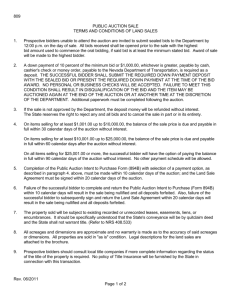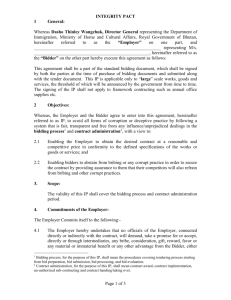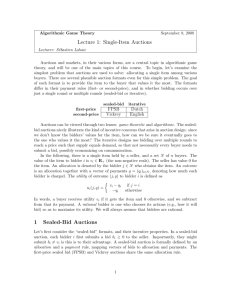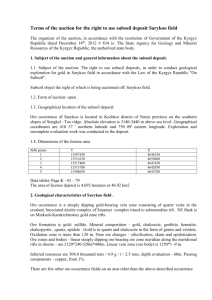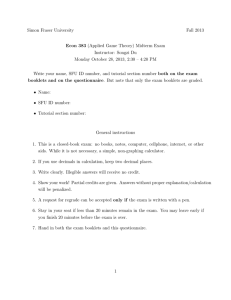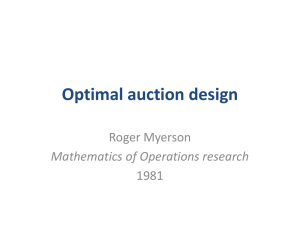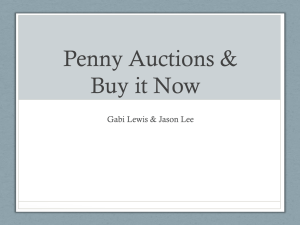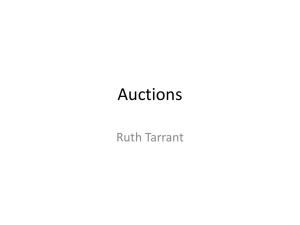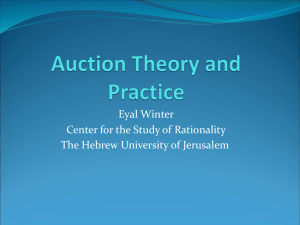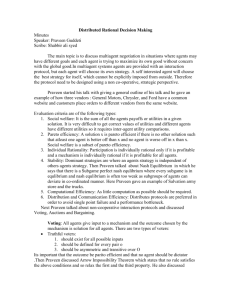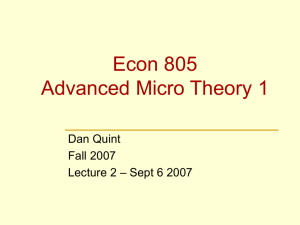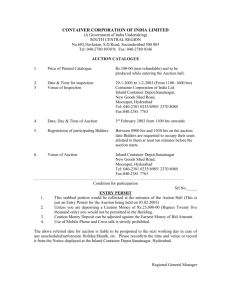Document
advertisement
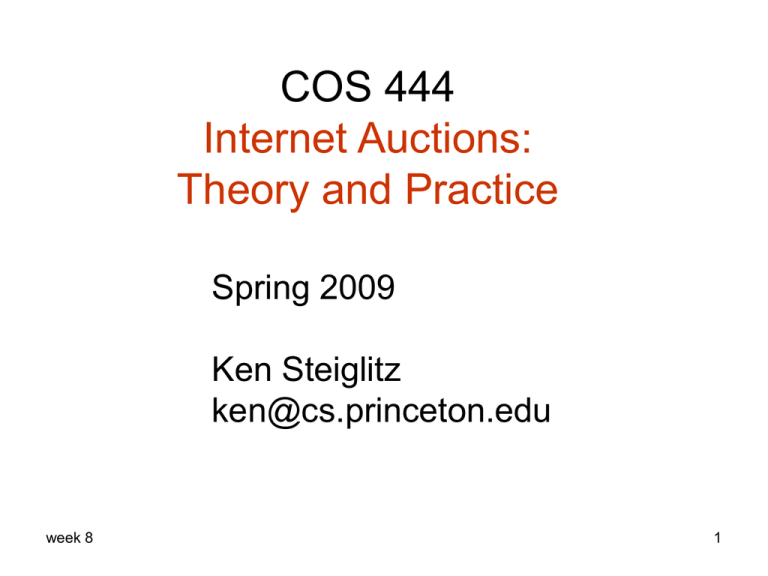
COS 444
Internet Auctions:
Theory and Practice
Spring 2009
Ken Steiglitz
ken@cs.princeton.edu
week 8
1
Some other auctions in Ars
All-pay with reserve
Consider simple case with n=2 and
uniform iid values on [0,1]. We also
choose the optimal v* = ½.
b ( v ) E [ pay ] vF ( v )
n 1
v
F ( y)
dy
v*
E [ surplus ] v b ( v )
2
n 1
v
2
2
v
2
2
2
v*
2
,
v v*
2
v*
2
,
v v*
How do we choose b0 to achieve this v* ?
week 8
2
All-pay with reserve
Standard argument: If your value is v* you win
if and only if you have no rival bidder. (This is
the point of indifference between bidding and
not bidding, and your expected surplus is 0.)
Therefore, bid as low as possible! Therefore,
b(v*) = b0 . And so b0 = v*2 = ¼ .
Notice that this is an example where the
reserve is not equal to the entry value v* .
week 8
3
week 8
4
Loser weeps auction, n=2, uniform v
Winner gets item for free, loser pays his bid! Auction
is in Ars . The expected payment is therefore
v
2
v
x dx b ( v )( 1 v ) E [ pay ]
v*
and therefore, choosing v* = ½ as before (optimally),
v 1/ 4
2
b (v )
2 (1 v )
,
v 1/ 2
( goes to ∞ !)
To find b0 , set E[surplus] = 0 at v = v* , and again
argue that b(v*) = b0 . This gives us
2
b0
week 8
v*
1 v*
1/ 2
5
week 8
6
Santa Claus auction, n=2, uniform v
• Winner pays her bid
• Idea: give people their expected surplus and
try to arrange things so bidding truthfully is an
equilibrium.
• Pay bidders
b
F ( y ) dy
v*
• To prove: truthful bidding is a SBNE
week 8
7
Santa Claus auction, con’t
Suppose 2 bids truthfully and 1 has value v
and bids b. Then
E[surplus]
b
F ( y ) dy ( v b ) F ( b )
v*
because F(b) = prob. winning. For equil.:
/ b F (b ) v f (b ) b f (b ) F (b ) 0
bv
week 8
□
(use reserve b0 = v* )
8
Matching auction: not in Ars
• Bidder 1 may tender an offer on a house,
b1 ≥ v*
• Bidder 2 currently leases house and has
the option of matching b1 and buying at
that price. If bidder 1 doesn’t bid, bidder 2
can buy at v* if he wants to
week 8
9
Matching auction: not in Ars
• To compare with optimal auctions, choose
v* = ½; uniform iid IPV’s on [0,1]
• Bidder 2’s best strategy: If 1 bids, match
b1 iff v2 ≥ b1 ; else bid ½ iff v2 ≥ ½
• Bidder 1 should choose b1 ≥ ½ so as to
maximize expected surplus. This turns out
to be b1 = ½ . To see this
week 8
10
Matching auction: not in Ars
Choose v* = ½ for comparison.
Bidder 1 tries to max
(v1 − b1 )·{ prob. 2 chooses not to match }
= (v1 − b1 )·b1
b1 = 0 if v1 < ½
= ½ if v1 ≥ ½ □
week 8
11
Matching auction: not in Ars
Notice:
When ½ < v2 < v1 , bidder 2 gets the item,
but values it less than bidder 1
inefficient!
E[revenue to seller] turns out to be 9/24
(optimal in Ars is 10/24; optimal with no
reserve is 8/24)
BTW, …why is this auction not in Ars ?
week 8
12
Risk aversion
Intuition: Suppose you care more
about losses than gains. How does
that affect your bidding strategy in
SP auctions? First-price auctions?
recall
week 8
13
Utility model
week 8
14
Risk aversion & revenue ranking
Result: Suppose bidders’ utility is
concave. Then with the assumptions
of Ars ,
RFP ≥ RSP
Proof: Let γ be the equilibrium
bidding function in the risk-averse
case, and β in the risk-neutral case.
week 8
15
Revenue ranking
Let the bidder bid as if her value is z,
while her actual value is x. In a first-price
auction, her expected surplus is
W ( z ) u ( x ( z ))
where W(z) = F(z)n-1 is the prob. of
winning. As usual, to find an equilibrium,
differentiate wrt z and set the result to 0
at z = x:
( x )
w ( x ) u ( x ( x ))
W ( x ) u ( x ( x ))
where w(x) = W΄(x).
week 8
16
Revenue ranking
In the risk neutral case this is just:
( x )
w( x)
( x ( x ))
W ( x)
The utility function is concave:
u ( x ) / u ( x ) x
week 8
17
Revenue ranking
Using this,
( x )
w( x)
( x ( x ))
W ( x)
Now we can see that γ΄(0) > β΄(0). If not, then
there would be an interval near 0 where γ ≤ β,
and then
( x )
w( x)
( x ( x )) ( x )
W ( x)
which would be a contradiction.
week 8
18
Revenue ranking
Also, it’s clear that γ(0) = β(0) = 0. So γ starts
out above β at the origin. To show that it stays
above β, consider what would happen should it
cross, say at x = x* :
*
( x )
*
w(x )
*
( x ( x ))
*
*
*
W (x )
*
w( x )
*
( x ( x ))
*
*
*
W (x )
( x )
*
A contradiction. □
week 8
19
Constant relative risk aversion (CRRA)
Defined by utility
u (t ) t ,
1
for concave
In this case we can solve [MRS 03]
( x )
for
w ( x ) u ( x ( x ))
W ( x ) u ( x ( x ))
(v ) v
v
F ( y)
( n 1 ) /
dy
0
F (v )
( n 1 ) /
Very similar to risk-neutral form, but bid as if
there were (n−1)/ρ instead of (n−1) rivals!
week 8
20

